The Ultimate GPS Antenna Cable Guide Active vs Passive, Loss & Types
Sep 11,2025
Introduction

This image is used to introduce the core concept of the guide: the performance of the entire GPS system depends on its weakest link, highlighting the cable as a critical component whose poor performance can lead to signal loss, timing drift, or precision degradation.
A GPS or GNSS system is only as good as the chain that ties it together. Think of it as three links—antenna, gps antenna cable, and receiver. If one link is weak, the entire system suffers. Even the most advanced antenna can’t perform well if the cable adds too much attenuation or mismatched impedance.
You’ll notice this in everyday use. A vehicle gps antenna might lose lock just as you’re driving through a tunnel. A gps timing PPS installation may drift slightly if the coax run is too long. And with RTK GNSS surveying, even a fraction of a decibel in extra line loss can throw off centimeter-level precision. These aren’t rare glitches; they’re the natural result of treating the cable as “just a wire.”
The truth is, the cable plays a decisive role in whether your receiver gets enough clean signal to function properly. Engineers often learn this the hard way when a setup that looks fine on paper struggles under real conditions. One practical tip: always plan your cabling early in the design phase, not as an afterthought. It can save hours of troubleshooting later.

This image showcases the different connector types commonly used in GPS antenna cable assemblies. It likely presents SMA (rugged, threaded, for outdoor routers), MCX/MMCX (small, push-on, for compact modules), U.FL (micro, for internal module connections), and FAKRA (automotive keyed, color-coded, often blue for GPS) side-by-side or labeled. The image visually emphasizes the importance of selecting the correct connector for the specific application (routers, vehicles, IoT devices) to avoid mismatches and performance issues.
What Is a GPS Antenna Cable?
At its simplest, a gps antenna cable is a 50-ohm coaxial line that connects an external antenna to the receiver or module inside your device. Its job may sound simple—carry the weak satellite signal from point A to point B—but in reality, the quality of this link often determines whether your system locks quickly or struggles in marginal conditions.
Several coax families dominate GPS applications: RG174, RG316, LMR100, RF1.13, and RF0.81. Each strikes a different balance of size, flexibility, and loss.
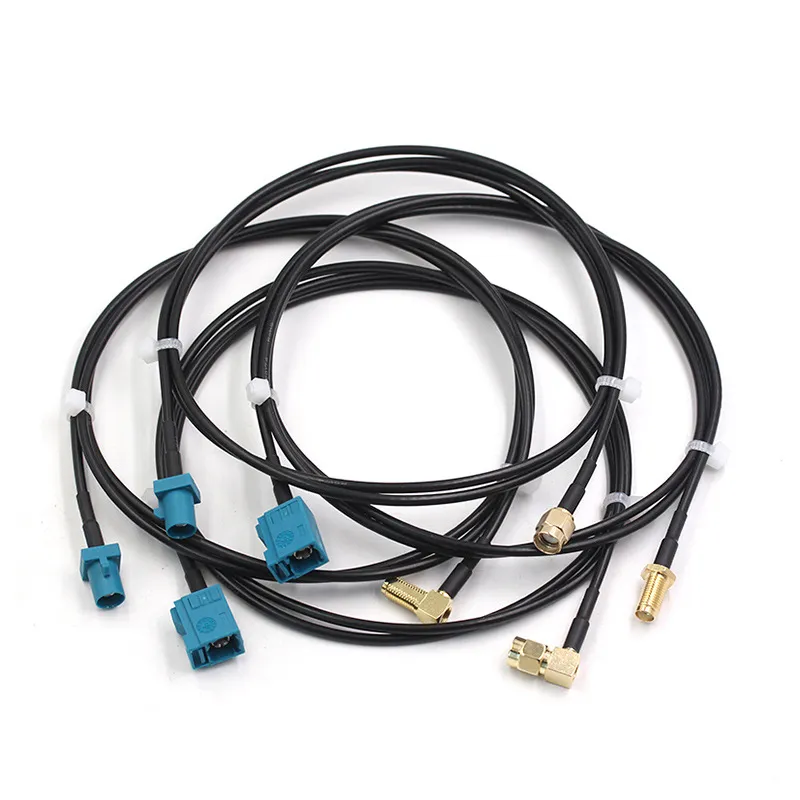
This image is a close-up of RG174 coaxial cable, accompanying the text describing its construction (bare copper conductor, PE insulation, PVC jacket) and characteristics (high flexibility, low cost, higher loss), commonly used for short pigtails or cost-sensitive applications.
- RG174 is the budget workhorse. It uses a bare copper conductor (7×0.16 mm) with PE insulation and a PVC jacket. Impedance sits at 50 ±2 Ω, capacitance is about 96 ±2 pF/m, and the velocity factor reaches 66%. The minimum bend radius is around 28 mm, with an operating range of –20 °C to +70 °C. It’s flexible and cheap, but in practice you’ll notice higher loss at GPS L1 (1.575 GHz). That’s why it shows up most often in short pigtails or extension leads where cost matters more than top performance.
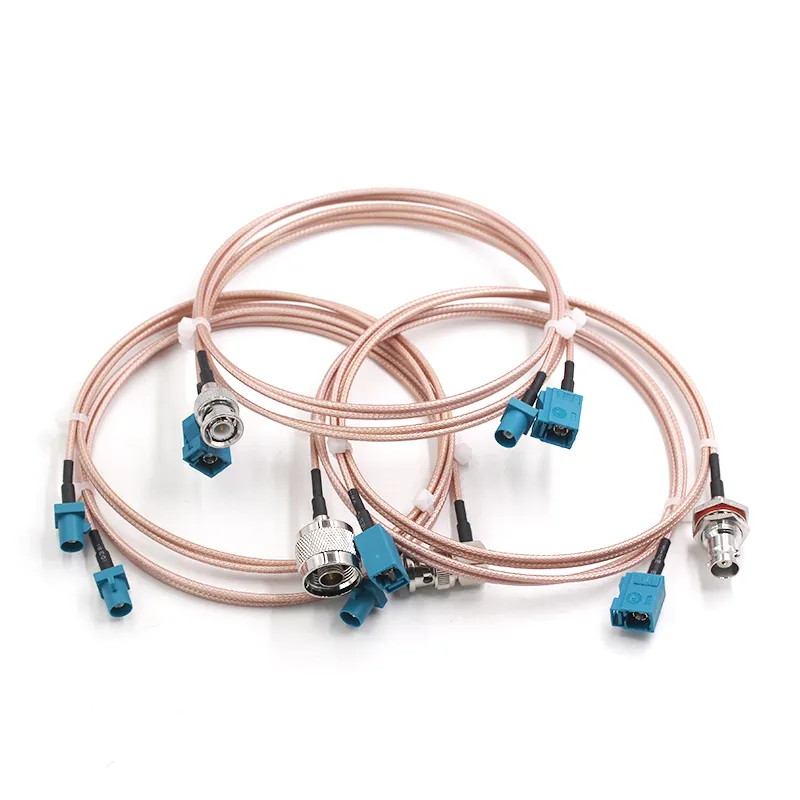
This image is a close-up of RG316 coaxial cable, accompanying the text emphasizing its superior properties over RG174 (silver-plated copper, PTFE insulation, wider operating temperature range, lower loss), making it a reliable choice for outdoor GPS SMA cable assemblies in routers or timing devices.
- RG316 is the upgrade option. Built with silver-plated copper and PTFE insulation, it withstands –55 °C to +150 °C and maintains better stability over time. Loss is lower—roughly 0.93 dB/m at 1 GHz and 1.46 dB/m at 2.4 GHz—making it a reliable pick for outdoor gps sma cable assemblies. If you’re planning a router installation exposed to heat, RG316 is often the safer bet.
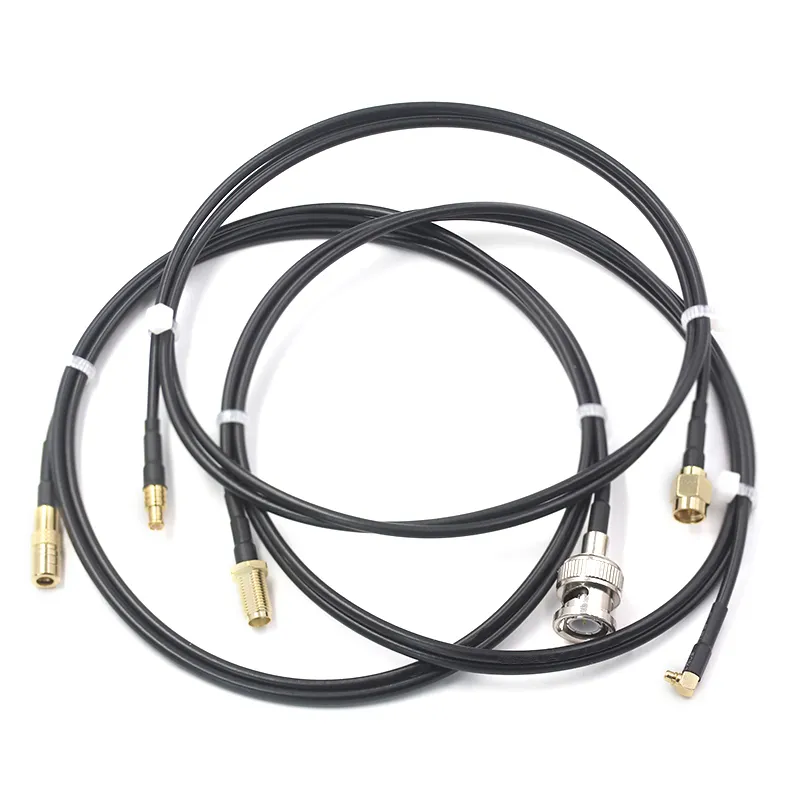
This image showcases LMR100 coaxial cable, highlighting its foil plus tinned copper braid shielding, accompanying the text describing its low loss and good shielding properties as an upgrade option over RG174 for situations requiring lower loss without moving to larger diameter cables.
- LMR100 splits the difference. With foil plus tinned copper braid shielding, it offers about 82 dB/100 m attenuation at 1 GHz. That translates into much less signal loss over short runs. It’s a common choice when installers want a low loss gps cable without moving up to bulkier lines like LMR240.
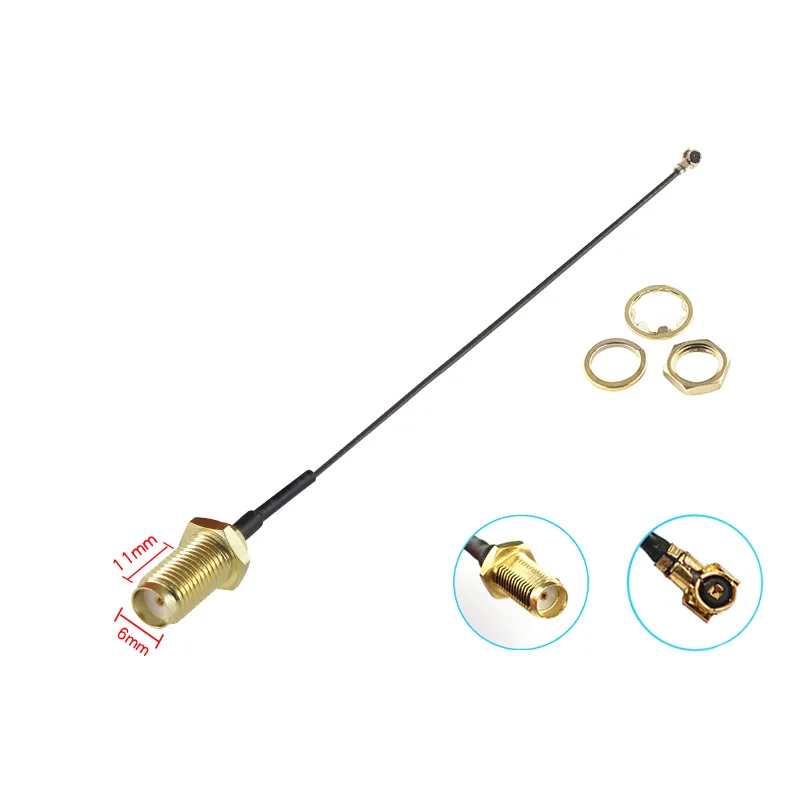
This image provides a visual comparison of the extremely thin outer diameters of RF1.13 and RF0.81 micro coaxial cables, accompanying the text explaining their suitability for space-constrained scenarios like embedded boards, GPS trackers, or IoT modules, but also warning about their rapidly increasing loss with length, making them suitable only for very short distances.
- RF1.13 and RF0.81 serve the ultra-compact end of the spectrum. These micro-coax types are perfect for embedded boards, GPS trackers, or IoT modules where every millimeter counts. But there’s a catch: loss rises sharply. RF0.81, for example, is already 3.1 dB/m at 1 GHz and jumps above 8 dB/m at 6 GHz. In real terms, that means these cables should stay very short—think internal pigtails under 20 cm—not long extensions.
Day to day, you’ll also hear two terms tossed around:
- A gps antenna extension cable simply stretches the distance, often using connectors like SMA male-to-female.
- A pigtail adapts small interfaces—such as u.fl to sma gps—and is intentionally short to minimize added loss.
For those who want a deeper look at specs, TEJTE’s RF coaxial cable overview compares attenuation, flexibility, and bend radius across all the common GPS coax types, from rugged RG174 to ultra-slim 0.81 mm.
Active vs Passive GPS Antennas
Picking the right antenna type is just as important as choosing the coax. In GPS systems, you’ll usually encounter two categories: active and passive GPS antennas. They may look similar on the outside, but they behave very differently once installed.
- A passive antenna is nothing more than a tuned element—typically a patch or helix—designed for GPS frequencies. It doesn’t require power and has fewer points of failure, which makes it reliable for simple builds. The trade-off is signal strength. Once the gps antenna cable gets longer than a few meters, especially with higher-loss lines like RG174, attenuation quickly eats into the weak satellite signal. That’s why passive setups are best for short runs, such as an antenna mounted directly on a device enclosure.
- An active antenna adds a low-noise amplifier (LNA) right at the feed point. Typical gains are in the 20–30 dB range, which means the signal is boosted before traveling through the coax. The amplifier’s noise figure is critical here—good designs keep it under 1.5 dB so the signal doesn’t just get louder, but stays clean. With an active antenna, you can comfortably use 5–10 m of RG174 or even longer runs with RG316 or LMR100 without starving the receiver.
Most receivers make powering simple. Instead of running a separate line, DC power is injected through the coax itself via a bias tee. Many router modules provide 3.3 V, while automotive units often supply 5 V through a fakra gps cable. It’s worth double-checking your module specs before ordering; mismatched voltage can cause headaches.
In practice, here’s the rule of thumb:
- Go with a passive GPS antenna when the run is short and you want a robust, no-power solution.
- Choose an active GPS antenna if cable length will be longer, or when you’re working with sensitive applications like rtk gnss or gps timing pps.
A small installer’s tip: if you’re not sure which you need, look at the module first. If it provides bias voltage on the antenna port, it’s designed for active use. If not, stick to passive.
For connector-specific insights, TEJTE’s SMA connector guide explains how SMA vs RP-SMA and other formats play into GPS cable assemblies.
Connector Types & Mating
When choosing a gps antenna cable, the connector style is just as critical as the coax itself. A mismatch here can lead to poor performance, mechanical wear, or even a cable you simply can’t plug in. The five most common connector types in GPS applications are SMA, MCX, MMCX, U.FL, and FAKRA—each designed with its own trade-offs.
- SMA connectors are rugged and threaded. They’re widely used in routers, timing receivers, and outdoor GPS setups. An SMA bulkhead makes it easy to pass a cable through a panel, while an IP67 waterproof SMA bulkhead can keep out rain and dust. This makes SMA a solid choice for outdoor gear where reliability is non-negotiable.
- MCX and MMCX are smaller, push-on connectors. You’ll find them on consumer GPS modules and compact IoT boards, where saving board space outweighs the need for threaded durability. Despite their small size, they maintain the required 50 Ω impedance for GPS L1 and L5.
- U.FL connectors (also known as IPEX) are micro-coax terminations used inside modules. They’re incredibly compact, but fragile and only rated for a handful of mating cycles. That’s why engineers almost always pair them with a u.fl to sma gps pigtail. This way, the delicate U.FL port stays safe while SMA takes the wear of repeated antenna swaps.
- FAKRA connectors are the automotive standard. They come with keyed housings and color coding—for example, blue almost always indicates GPS/GNSS. A fakra gps cable locks firmly into place, resists vibration, and integrates seamlessly into car harnesses. Anyone who has pulled apart a dashboard knows why FAKRA exists: it makes assembly foolproof and service-friendly.
The quick rule of thumb:
- Use gps sma cable assemblies for routers, outdoor devices, and industrial builds.
- Go with FAKRA in vehicles, where vibration resistance and color coding matter.
- Stick to U.FL, MCX, or MMCX inside modules or space-constrained designs, but keep them short and protected.
For a deeper dive into gender codes, mechanical standards, and SMA variations, TEJTE’s SMA connector guide is a handy reference.
Coax Choices: RG174 / RG316 / LMR-100 / 1.13 / 0.81
| Cable Type | OD (mm) | Attenuation @1 GHz | Temp Range | Notes |
|---|---|---|---|---|
| RG174 | 2.85 | ~1.5 dB/m | -20 to +70 °C | Flexible, low-cost, but higher loss |
| RG316 | 2.5 | ~0.93 dB/m | -55 to +150 °C | Silver-plated copper, stable at high temp |
| LMR100 | 2.9 | 0.82 dB/m (82 dB/100 m) | -20 to +80 °C | Excellent shielding, low loss |
| RF1.13 | 1.13 | ≤2.3 dB/m @1 GHz | -20 to +80 °C | Ultra-thin, good for GPS trackers |
| RF0.81 | 0.81 | ~3.1 dB/m @1 GHz | -20 to +80 °C | Very compact, but only for short runs |
- RG174 is the industry workhorse. It bends easily, costs little, and shows up everywhere from cheap extension leads to basic vehicle harnesses. The downside? Higher loss, which becomes obvious in longer GPS antenna runs.
- RG316 is a premium upgrade. Its PTFE dielectric and silver-plated copper conductors handle heat and maintain stable loss figures. If you’ve ever installed an outdoor GPS SMA cable on a router or timing device, chances are it used RG316.
- LMR100 offers strong shielding thanks to its foil plus tinned copper braid. Its lower attenuation (about 0.82 dB/m at 1 GHz) makes it ideal for anyone needing a low loss gps cable without moving to larger diameters like LMR200.
- RF1.13 and RF0.81 sit on the opposite end. They’re tiny—perfect for IoT trackers or modules where space is tight—but their losses pile up fast. For example, RF0.81 hits 3.1 dB/m at 1 GHz. In practice, keep these under 30 cm if you care about performance.

This collage illustrates various application scenarios for GPS antenna cables (likely including power facilities [interpreting 'Electricite steaming' contextually], data centers, home/office networks, home NAS), aiming to demonstrate that cable selection depends on the specific deployment environment (indoor/outdoor, short/long distance, cost/performance).
A quick installer’s note: if you’re not sure which cable to specify, start with the environment. Indoors or short jumpers? RG174 works fine. Outdoor routers in hot climates? RG316 is safer. Precision timing or RTK? Choose LMR100. And if space is at a premium, RF1.13 or 0.81 will do the job—as long as you keep them short.
For more detailed specifications and bend radius data, TEJTE’s RF coaxial cable options provide a clear comparison across all major GPS coax families.
Length Planning & Loss Budget
Cable length is where theory meets the real world. Every coaxial line introduces attenuation, and with GPS signals already arriving at around –130 dBm, even small losses can tip the balance. That’s why installers often talk about “gain–loss–sensitivity” as a triangle: the antenna gain, the coax loss, and the receiver’s noise figure must all stay in harmony.
Here’s a practical breakdown:
- With a passive GPS antenna (no built-in amplifier), try to keep RG174 runs under 3 m. If you step up to LMR100, you can stretch a little further, maybe 4–5 m, before performance noticeably degrades. Beyond that, you’ll often see longer time-to-first-fix or dropped locks under trees and buildings.
- With an active GPS antenna using a 28 dB LNA, you can push much farther. A 5–10 m RG174 gps antenna cable is realistic, and even longer if you choose lower-loss options like RG316 or LMR100. The amplifier boosts the signal before loss accumulates, so the receiver still sees a healthy margin.
- For RTK GNSS or gps timing pps setups, the rules get stricter. It’s not just about having enough signal; it’s about phase stability and group delay. Even if the active antenna gain seems to cover the loss, inconsistencies between cables can shift results. Many engineers solve this by using low loss gps cable assemblies like RG316 or LMR100, cut to precise lengths, so every receiver in a system behaves consistently.
Here’s a quick reference table showing typical attenuation and practical cable lengths:
| Cable | Loss @1.575 GHz (dB/m) | Max Passive Length | Max Active Length (28 dB gain) |
|---|---|---|---|
| RG174 | ~1.2–1.5 | 2–3 m | 8–10 m |
| RG316 | ~0.9 | 3–4 m | 10–15 m |
| LMR100 | ~0.82 | 4–5 m | 12–15 m |
| RF1.13 | ~2.3 | ≤1 m | 3–4 m |
| RF0.81 | ~3.1 | ≤0.5 m | 2–3 m |
These aren’t hard limits—receivers may still lock past them—but performance often becomes unstable, especially in urban canyons or under heavy foliage. One field tip: if you’re pushing the edge of these ranges, always test under worst-case conditions (trees, rain, buildings), not just in open sky.
For engineers needing more data on attenuation and impedance control, TEJTE’s RF coaxial cable guide dives deeper into measurement details and best practices.
Dual-Band & GNSS Coverage
Modern GPS modules rarely stop at a single frequency anymore. Many support dual-band antennas, pulling in both L1 (1575 MHz) and L5 (1176 MHz). Why does that matter? Because with two bands, receivers can correct for ionospheric errors, achieve faster fixes, and reduce multipath interference. The catch is that higher frequencies—especially L5—are more sensitive to line loss, so coax selection becomes even more important.
For serious applications, a low loss gps cable such as LMR100 or RG316 is strongly recommended. These cables maintain stable attenuation across a wider frequency range, giving the receiver enough clean power to work with. In contrast, a long run of RG174 can eat away too much of the L5 signal, even if the L1 channel still looks acceptable.
Multi-constellation systems add another layer. It’s now common to see GNSS antenna cable assemblies covering not just GPS, but also GLONASS, Galileo, and BeiDou. Because each constellation uses slightly different frequencies, impedance stability and shielding are critical. A cable like RG316, with its silver-plated conductor and PTFE insulation, offers the wideband consistency these setups demand.
Compact IoT devices often use RF1.13 or RF0.81 cables. They can technically support GNSS, but only at very short lengths—think 10–20 cm inside a tracker. Once the run gets longer, the attenuation margin collapses quickly.
Here’s a quick rule of thumb from field experience:
- Surveying or RTK GNSS: dual-band active antenna (≥28 dB gain) + LMR100 coax.
- Consumer navigation: single-band passive antenna + RG174 (short runs).
- Routers and telecom timing: active antenna + RG316 for stable dual-band operation.
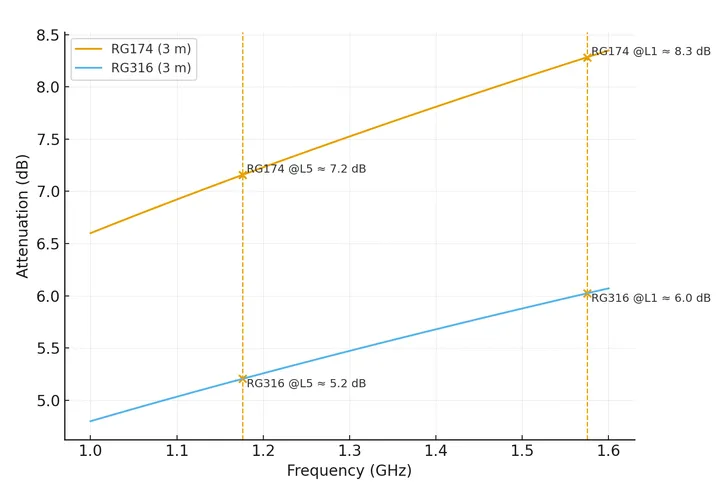
This chart quantifies the difference in signal attenuation between RG174 and RG316 cables at key GPS frequencies (L1 1575 MHz, L5 1176 MHz) (e.g., RG174 @L1 ~4.5dB/3m, RG316 @L5 ~2.7dB/3m), visually demonstrating the importance of choosing low-loss cables for dual-band GNSS applications, especially over longer distances or at higher frequencies (L5).
Panel Mount & Outdoor Builds
When a GPS antenna has to pass through an enclosure wall, the cable design shifts from “signal only” to “signal plus protection.” A typical solution is a panel mount gps cable with an SMA bulkhead connector. The threaded body passes through the chassis, secured with a nut, while an O-ring seal presses against the surface to keep out water and dust. In outdoor builds, an IP67 waterproof SMA bulkhead is often the difference between a system that lasts for years and one that fails after the first storm.
These assemblies are common in industrial timing equipment, outdoor routers, and vehicle-mounted systems. They provide more than just weather protection. A bulkhead also establishes a solid ground connection between the cable shield and the device housing, which helps reduce EMI issues.
Cable choice matters here, too. RG316 is a favorite because it tolerates high heat (up to 150 °C) and has a small minimum bend radius, making it easier to route inside cramped housings. LMR100 brings stronger shielding and slightly lower loss, so it’s a solid pick for outdoor low loss gps cable assemblies. RG174 may still be used where cost is a concern, but in long-term outdoor deployments it’s not as stable under temperature swings.
A few practical tips from installers:
- Always double-check O-ring compression. Too loose, and moisture seeps in; too tight, and the seal deforms.
- Add strain relief inside the chassis. A simple grommet or zip tie can prevent mechanical stress from pulling on the connector.
- Don’t skip grounding. A floating bulkhead may still pass signal, but it won’t protect against interference.
For deeper details on connector durability, TEJTE’s SMA bulkhead connector guide covers thread lengths, sealing, and mounting options in outdoor scenarios.
Vehicle & Router Use Cases
Two of the most common environments for gps antenna cable assemblies are vehicles and networking devices. At first glance, they may seem unrelated, but both demand reliability in noisy, signal-sensitive conditions.
- Vehicle GPS antennas almost always use fakra gps cable assemblies. FAKRA housings are keyed for foolproof installation, and their blue color code identifies GPS/GNSS without confusion. Standard lengths—1.5 m, 3 m, or 5 m—fit most dashboards and telematics units. Many automakers still rely on RG174 because it’s inexpensive and flexible enough for routing through tight spaces. Higher-end cars, or applications where precision navigation is a selling point, often step up to RG316 or LMR100 to reduce loss and improve long-term stability. If you’ve ever pulled apart a factory harness, you’ll notice the cables are bundled neatly and strain-relieved—OEMs don’t leave this to chance.
- Router GPS antennas usually terminate in SMA connectors. This makes them easy to mount through housings with bulkheads or to pair with extension cables. Depending on design, routers may power an active GPS antenna at 3.3 V through the coax, or in some industrial gear, at 5 V. Inside the device, space is often limited, so you’ll find rf1.13 or rf0.81 pigtails running from the module to the panel-mounted SMA port. Once outside, those pigtails usually transition into sturdier cables like RG316 for outdoor routing.
One practical difference is tolerance for loss. A vehicle telematics module can usually tolerate a 5 m rg174 gps extension cable and still lock satellites reliably. A timing router, on the other hand, might require a low loss gps cable such as LMR100 to maintain precise synchronization. That’s why you’ll often see networking deployments over-spec their cabling—better safe than sorry when timing accuracy is mission critical.
For further reading on how SMA-based cabling strategies carry over between GPS and WiFi builds, see TEJTE’s WiFi antenna extension cable guide.
RTK & Timing
When it comes to RTK GNSS and gps timing pps systems, the rules change. These setups don’t just need “a signal”—they demand phase stability, consistent delay, and low noise. Even small variations in a gps antenna cable can show up as measurable errors.
Take RTK surveying as an example. A few nanoseconds of extra group delay in one cable can translate to several centimeters of positioning error. That’s why field engineers almost always specify low loss gps cable assemblies like LMR100 or RG316. Both offer stable attenuation and better shielding across temperature swings. Micro-coax options like RF1.13 or RF0.81 are sometimes used inside compact modules, but in real deployments they should be kept under 20–30 cm. Longer runs risk introducing unpredictable delay shifts that break RTK accuracy.
Timing applications—such as synchronizing telecom base stations, smart grids, or even financial systems—are equally sensitive. A gps timing pps antenna may have 28 dB of gain, but if two receivers use cables of different types or lengths, their PPS outputs will drift apart. For that reason, integrators often order cables cut to precise lengths, matched within ±1 cm. They may also request test reports confirming VSWR, impedance uniformity, and delay consistency across a batch.
One small tip from deployment teams: always plan cables in pairs or sets, even if you only need one today. Having matched spares avoids the frustration of timing offsets when you expand later.
For engineers planning precision GNSS or timing systems, TEJTE’s RF coaxial cable guide and connector selection overview are reliable starting points. They explain impedance control, shielding design, and length planning in more depth.
Quick Selector Table
| Application | Connector | Cable Options | Attenuation @1.575 GHz | Typical Length | Notes |
|---|---|---|---|---|---|
| Vehicle GPS antenna | FAKRA (blue) | RG174 / RG316 | ~1.5 dB/m (RG174), ~0.9 dB/m (RG316) | 1.5-5 m | Flexible harness, color-coded housing; commonly used in cars. |
| Router GPS / LTE-GNSS combo | SMA | RF1.13 / RF0.81 (internal), RG316 (external) | ~2.3 dB/m (RF1.13), ~3.1 dB/m (RF0.81) | ≤0.5 m (pigtail), 1-3 m (external) | Short internal jumpers plus SMA bulkhead extension; good for IoT routers. |
| Timing PPS | SMA / N-type | LMR100 / RG316 | ~0.82-0.9 dB/m | 5-10 m | Length-matched cables for consistent delay; critical for synchronization. |
| RTK GNSS surveying | SMA / MCX | RG316 / LMR100 | ~0.9 dB/m | 3-8 m | Prioritize phase stability and shielding; used in high-precision environments. |
| IoT trackers | U.FL / MMCX | RF0.81 / RF1.13 | ~3-6 dB/m | ≤0.3 m | Ultra-thin, space-saving, but only for short runs inside devices. |
This table isn’t exhaustive, but it should give you a good starting point for choosing the right cable based on your application. As always, it’s crucial to balance signal loss, flexibility, and cable length to meet your specific system needs.
Pro Tip: If you’re unsure about your system’s specific length requirements, always measure and leave a little extra slack. It’s easier to trim a cable than to stretch one that’s too short!
If you need a deeper dive into the differences between these cables and when each is ideal, TEJTE’s SMA vs BNC vs N-Type guide provides additional details on connectors.
Ordering & Custom Options
While stock GPS cables often cover the basics—SMA or FAKRA connectors, standard lengths like 1 m, 3 m, or 5 m, and common coax types like RG174—more demanding projects require custom builds. Custom cables not only ensure the best performance but also save time and effort in the long run.
When ordering custom gps antenna cable assemblies, consider the following options:
- Length: For RTK and timing setups, it’s crucial to request precise cut lengths to avoid signal delay inconsistencies. Even a few centimeters of cable length mismatch between receivers can cause timing drift, which is especially problematic in high-precision applications like RTK GNSS or GPS timing PPS.
- Connector combinations: If you’re working with non-standard connectors, such as SMA to U.FL or FAKRA to MMCX, ensure that your assembly matches your system’s needs. SMA bulkhead to pigtail combos are commonly used for external setups, but if you’re installing antennas inside enclosures, smaller connectors like MCX or MMCX may work better.
- Cable type: You can upgrade from RG174 to RG316 or LMR100 for lower loss, or choose RF1.13 or RF0.81 for compact designs where space is limited. Remember: the higher the attenuation, the shorter the cable length should be for optimal performance.
- Jacket color and material: Custom assemblies allow you to choose from various jacket colors (e.g., black PVC for indoor use, PTFE or FEP for outdoor builds). High-temperature applications, like those in automotive or industrial environments, require jackets that withstand temperatures up to 150°C, which is where PTFE or FEP come in.
- Batch testing: Request VSWR (Voltage Standing Wave Ratio) and impedance checks across multiple cable samples, especially if you’re ordering in bulk. Ensuring consistency across every cable in a batch guarantees uniform performance in real-world deployments.
Installation Tip: Always think ahead—if your system may expand, order extra cables with slightly longer lengths. Custom builds are often faster and more reliable than “field-modified” cables that don’t match the system’s original design.
For more details on how to tailor your assemblies for different applications, TEJTE’s RF cable product page lists various coax types and custom options.
FAQs
Q1: How do I pick the right gps antenna cable?
It starts with your application. For a vehicle gps antenna, FAKRA gps cables with RG174 or RG316 are standard. For routers, SMA-terminated cables are more common. If you’re working with RTK or timing systems, opt for low loss gps cable like LMR100. TEJTE’s RF coaxial cable guide helps you compare the options and pick the right one based on your system’s requirements.
Q2: What type of coaxial cable works best for GPS antennas?
It depends on the environment and run length. RG174 is affordable but has higher loss, so it’s best for shorter runs. RG316 balances flexibility and low loss, making it ideal for outdoor setups. For longer runs or high-performance needs, LMR100 offers excellent shielding and low attenuation. TEJTE’s GPS SMA cable options provide more detailed guidance.
Q3: How does coaxial cable work with an active GPS antenna?
An active GPS antenna integrates a low-noise amplifier (LNA) to boost the signal. The gps antenna cable doesn’t just carry the signal—it also delivers power (3.3 V or 5 V) through the coax via a bias tee. Maintaining consistent impedance along the cable is key to preserving signal quality, and that’s where SMA or MCX connectors come into play.
Q4: Is a GPS antenna cable just a regular coax cable?
Yes, it’s a 50 Ω coaxial line, but specialized cables for GPS have specific requirements for shielding, attenuation, and connector types like SMA, MCX, or U.FL. Standard coax cables may not offer the same durability or low loss necessary for GPS systems, which is why you’ll need a dedicated GPS cable for reliable performance.
Q5: Can I splice a gps antenna cable myself?
It’s generally not recommended. Splicing can disrupt the 50 Ω impedance, leading to signal loss and mismatched connectors. It also affects waterproofing, which is especially important in outdoor installations. If you need longer runs, it’s best to order a gps antenna extension cable built for your specific needs.
Q6: What color is the GPS cable in a 2016 BMW X3 antenna?
In vehicles, GPS lines are often color-coded. For example, in many cars like the BMW X3, the FAKRA connector for GPS is usually blue, helping installers easily identify it among the other vehicle wiring.
Q7: How to make a GPS antenna cable or wire diagram?
Creating a gps antenna cable diagram requires precision, especially with impedance control and shielding. If you’re considering DIY cable assembly, note that you’ll need proper crimping tools and a solid understanding of VSWR to avoid signal loss. For most applications, though, it’s best to rely on professional assemblies to ensure consistency and performance.
For a clearer understanding of connector types and assembly best practices, TEJTE’s SMA adapter guide explains the technical side of connecting GPS antennas.
References
To ensure the accuracy of this guide, we’ve referenced authoritative sources that complement TEJTE’s product expertise. These external resources will provide you with deeper technical insights into GPS and GNSS systems, coaxial cable properties, and industry standards.
- NIST – RF Measurement Guidelines – Offers foundational knowledge on impedance, attenuation, and coaxial cable properties.
- ESA GNSS Basics – Explains the fundamentals of GPS, GLONASS, Galileo, and BeiDou, and how these systems work together.
- IEEE Xplore – Coaxial Cable Properties – Provides detailed technical references on coaxial cable materials, performance, and shielding effectiveness.
- GNSS Wikipedia Overview – A comprehensive overview of GNSS, including signal structure, frequency bands, and real-world applications.
For hands-on product specifications and real-world testing, TEJTE’s RF coaxial cable product page offers the most up-to-date parameters and selection advice.
These resources are selected for their academic, technical, and non-commercial nature, ensuring that you can trust the information presented.
Conclusion
A gps antenna cable may look like a simple wire, but it plays a decisive role in GNSS performance. Whether you’re extending a router gps antenna, wiring a vehicle gps antenna harness, or deploying rtk gnss for surveying, the choices of coax type, connector, and antenna design all matter.
- For short, low-cost builds, RG174 works but expect higher loss.
- For heat and outdoor reliability, RG316 or LMR100 offer lower attenuation.
- For compact IoT boards, rf1.13 and rf0.81 keep things small, but only at very short runs.
- Match connectors carefully—SMA for routers, FAKRA for cars, U.FL for modules—to avoid mismatches and installation headaches.
- Finally, balance antenna type: active gps antennas extend usable cable length, while passive designs keep things simple.
By understanding these trade-offs, you can select cables that deliver reliable positioning, stable timing, and long-term durability. If you need assemblies tailored to your project, TEJTE offers custom gps antenna extension cables with real-world testing, ensuring both performance and consistency across batches.
Bonfon Office Building, Longgang District, Shenzhen City, Guangdong Province, China

A China-based OEM/ODM RF communications supplier
Table of Contents
Owning your OEM/ODM/Private Label for Electronic Devices andComponents is now easier than ever.
